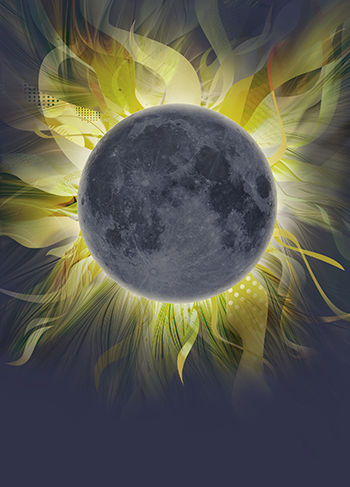April 1–April 29, 2024
This exhibit features artworks, posters, and information about the 2024 total solar eclipse. The exhibit features original artwork by Vi Nguyen, Kristen Perrin, Tyler Nordgren, Michael Lentz, and Howard Russell Butler.
Vi Nguyen’s representation of a total solar eclipse includes a new moon in the foreground and the Sun’s corona visible in the background. This stylized illustration, created for the 2024 total solar eclipse, shows Earth’s Moon blocking the Sun from view and revealing the Sun’s corona, or outermost atmosphere. The Sun’s magnetic field affects charged particles in the corona, causing elaborate streamers and plumes that are depicted in this artist’s interpretation.
For her “Through the Eyes of NASA” poster, Kristen Perrin — who is an African American woman, mother of four, and the senior multimedia and graphic specialist on the NASA Heliophysics communications team — said she wanted to show that the eclipse is an experience for everyone.
In his “The Sun and Moon Align with You” poster for NASA, Tyler Nordgren, professional astronomer as well as artist, said that his goal was to capture the experience that can be had by millions of people in cities across the United States in April, while reflecting on the last total solar eclipse that crossed the country in August 2017.
Michael Lentz is an art director and artist who has worked with respected organizations such as National Geographic, Discovery, and now NASA. When given the task of creating an eclipse piece, Michael was intrigued by how different landscapes could change the feel of this celestial event. He worked up a few different environments, but his love for forests and mountains led him to the setting he chose. As for style, he was inspired by the simplicity and elegance of Japanese woodblock prints or Ukiyo-e, which translates to “pictures of the floating world” — a phrase he found fitting for an eclipse.
From 1918 until he died in 1934, Howard Russell Butler tracked down and painted four total solar eclipses. The artist’s first was in Oregon (1918), the second in California (1923), the third in Connecticut (1925), and the fourth in his backyard in Maine (1932).
